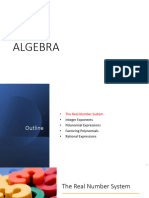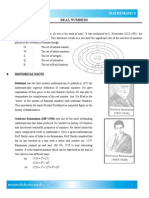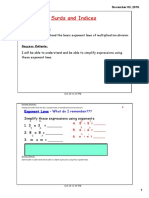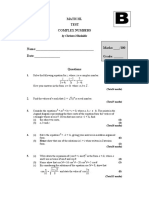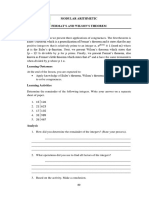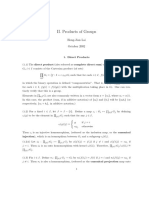Number System
• Rational Number :- a number r is said to be a rational number , if it can
be written in the form of a ( p/q ) , where p and q are integers and q≠0 .
Example:- ½,45/8,0/5,etc .
• Rational Number :- a number whose decimal expansion is either
terminating or non-terminating repeating(recuring) is said to be a
rational number .
Example:- 1.5,1.254788963,2.145145145145…,etc .
• Irrational Number :- a number s is said to be a irrational number , if it
can not be written in the form of a ( p/q ) , where p and q are integers
and q≠0 .
2 3
Example :- √2,√3,√5,√5, etc.
• Irrational Number :- a number whose decimal expansion is non-
terminating non-repeating(non-recuring) is said to be a irrational
number.
Example :- 0.110110111011110…. , 3.142857142857143…. , etc .
• Terminating :- a decimal expansion is end at any stage .
Example :- 3.14, 4.1526368 , etc.
• Non-Terminating :- a decimal expansion is not end any stage .
Example :- 0.10110111011110……. , π , ⅇ , etc .
• Recuring :- a decimal expansion is repeated at any stage .
Example :- 3.145145145145145…. , 7.1212121212…… , 3.12 ̅̅̅̅ ,etc .
• Non-Recuring :- a decimal expansion is not repeated at any stage .
Example :- 0.10110111011110…. , 3.14161512579842136 , π , etc .
• Non-Terminating Recuring :- a decimal expansion is not end at any stage
and decimal expansion is repeating at any stage .
Example :- 3.141414141414… , 5.7272727272… , etc .
• Non-Terminating Non-recuring :- a decimal expansion is not end and not
repeated at any stage .
Example :- 0.1011011101111011110……. , 3.14165897231456877125….. , π ,
e , etc .
• There are infinite rational & irrational numbers between two rational
number .
• There are infinite irrational numbers between two irrational number .
1
�• Every integers is a rational numbers but every rational numbers is not a
integers .
• Every real numbers is represented by a unique point on the number line.
Also, every point on the number line represents a unique real number.
That is why we call the number line, the real number line.
• Operation of a real numbers :-
➢ Addition of a real numbers
➢ Subtraction of a real numbers
➢ Multiplication of a real numbers
➢ Division of a real numbers
• Commutative property :-
1. a + b = b + a (for addition)
2. xy = yx (for multiplication)
• Associative Property :-
1. a + (b + c) = (a + b) + c (for addition)
2. 𝑎 ∗ (𝑏 ∗ 𝑐) = (𝑎 ∗ 𝑏) ∗ 𝑐 (for multiplication)
• Distributive Property :-
a (b + c) = ab + ac
• If we add, subtract, multiply or divide (except zero) two rational
numbers, we get a rational number ,where r is a rational number.
1. r + r = r
2. r – r = r
3. r * r = r
4. r / r = r
• If we add, subtract, multiply or divide two irrational numbers are not
always irrational .
• If we add, multiply of a rational and a irrational number, we gat a
irrational number.
• 𝒂𝒑 ⋅ 𝒂𝒒 = 𝒂𝒑+𝒒
• (𝒂𝒑 )𝒒 = 𝒂𝒑𝒒
𝒂𝒑
• = 𝒂𝒑−𝒒
𝒂𝒒
• 𝒂 𝒃 = (𝒂𝒃)𝒑
𝒑 𝒑
• 𝒂𝟎 = 𝟏
𝟏
• = 𝒂−𝒑
𝒂𝒑


















































